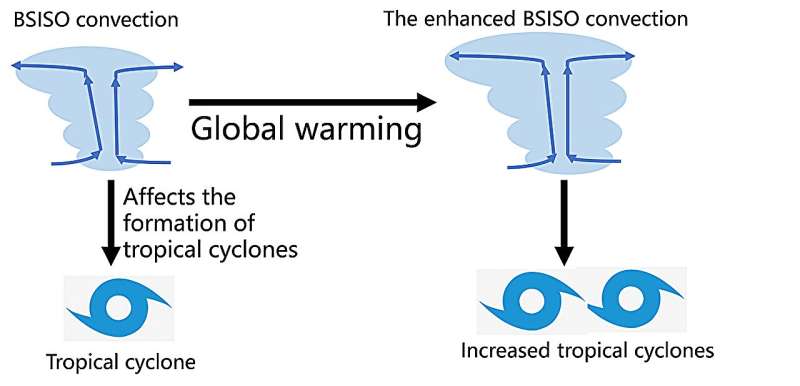This article has been reviewed according to Science X's editorial process and policies. Editors have highlighted the following attributes while ensuring the content's credibility:
fact-checked
trusted source
proofread
Global warming may intensify the modulation of tropical cyclone genesis by summer intraseasonal oscillation

Global warming, the long-term warming of Earth's overall temperature, has greatly accelerated in the last 100 years due to human factors such as the burning of fossil fuels. Along with this trend, certain atmospheric phenomena have also changed, such as typhoons and other types of disastrous weather becoming more intense than before and bringing about more serious impacts.
The Boreal Summer Intraseasonal Oscillation (BSISO), one of the most pronounced subseasonal variabilities in the tropics during boreal summer, provides an important basis for subseasonal forecasting. Therefore, it is of great significance to study the BSISO and its changes under global warming.
Recently, the research group of Prof. Chaoxia Yuan from Nanjing University of Information Science and Technology compared the characteristics of BSISO activities in the northwest Pacific Ocean before and after global warming on the basis of the simulation results of a state-of-the-art climate model (EC-Earth3P-HR) and discussed the possible effects of BSISO changes on the generation of tropical cyclones under global warming.
The results have been published in Atmospheric and Oceanic Science Letters.
The BSISO has a period of 30 to 90 days and is mainly active in the Northern Hemisphere summer from May to October. Its life cycle is usually characterized by convective activity spreading from the tropical Indian Ocean to the western North Pacific Ocean. The BSISO can modulate the activity of tropical cyclones by adjusting the large-scale dynamic and thermal atmospheric conditions.
During the convectively active period of the BSISO, the background convection and circulation, as well as the water vapor conditions, tend to be more favorable for the generation of tropical cyclones, while the opposite is true during the convectively suppressed period.
A comparison of the simulations before and after global warming produced by EC-Earth3P-HR showed that, under global warming, the water vapor content in the atmosphere increases, leading to an enhancement of BSISO convective activities. The BSISO circulation over the northwest Pacific Ocean moves to the northeast, showing an enhanced convective zone distributed in the northwest to southeast direction.
"The formation density of tropical cyclones also increases significantly in the area of convective enhancement; and, according to results from analyzing the genetic potential index, we found that the formation activity of tropical cyclones is better reflected," explains Prof. Yuan.
"Therefore, further analysis showed that the relative humidity in the middle troposphere plays a leading role. Enhanced BSISO convection within the zone moistens the mid-tropospheric air, which helps to reduce the entrainment of normally dry tropospheric air by updrafts and the correction of the boundary layer by downdrafts, resulting in an enhanced density of tropical cyclone formation."
More information: Zhefan Gao et al, Changes in tropical cyclone response to the Boreal Summer Intraseasonal Oscillation in the western North Pacific under global warming in EC-Earth3P-HR, Atmospheric and Oceanic Science Letters (2024). DOI: 10.1016/j.aosl.2024.100482
Provided by Chinese Academy of Sciences




















